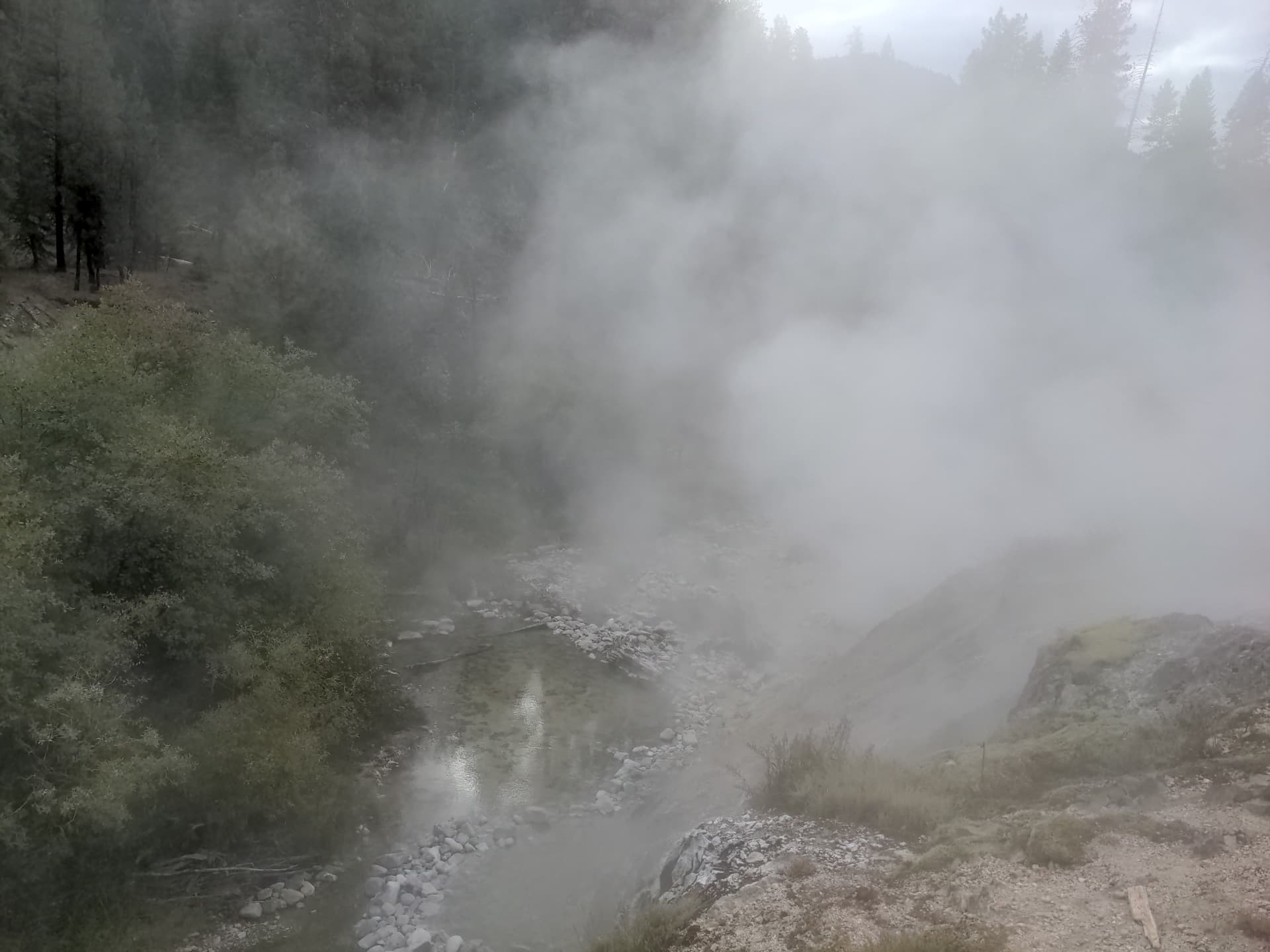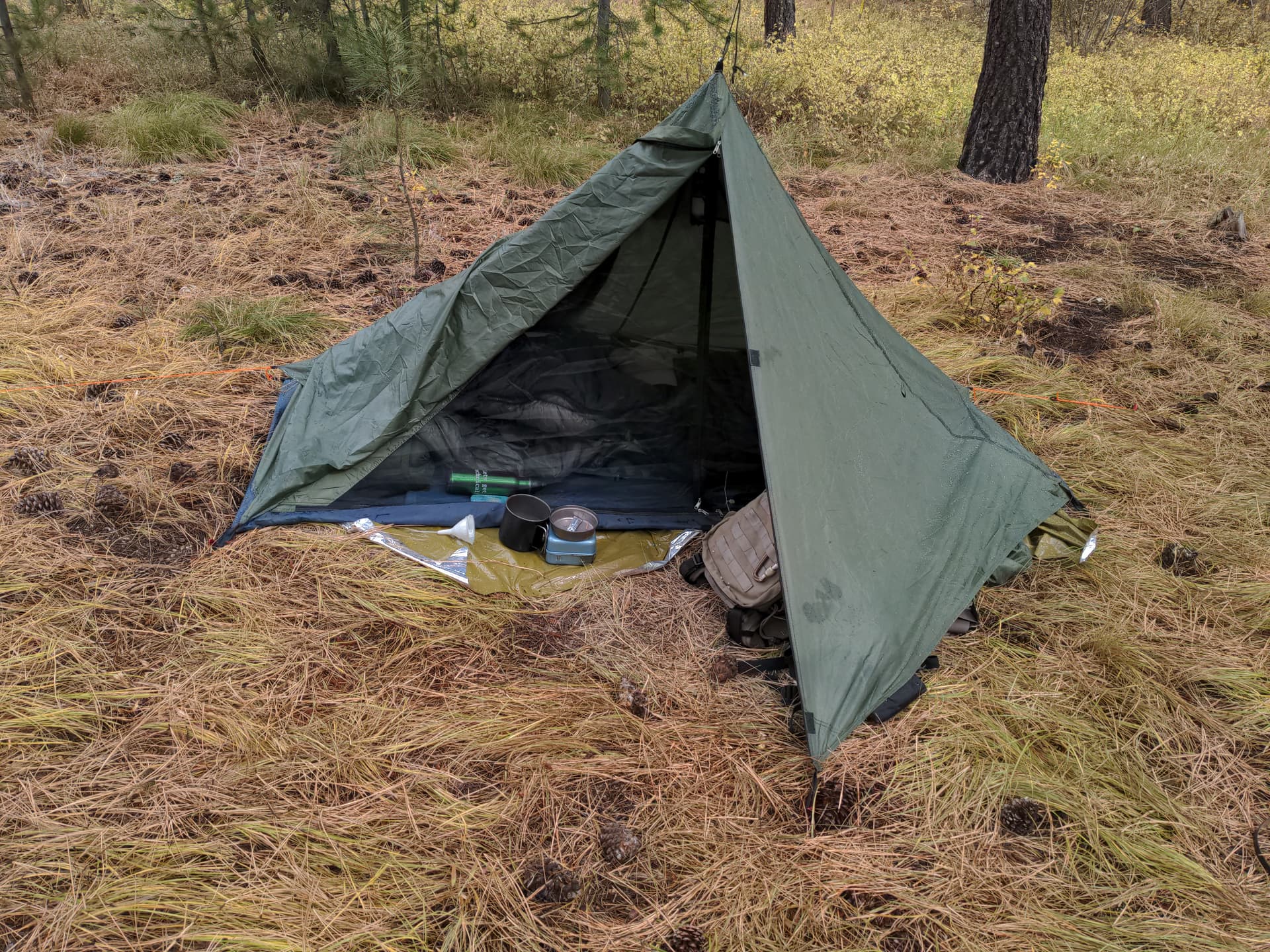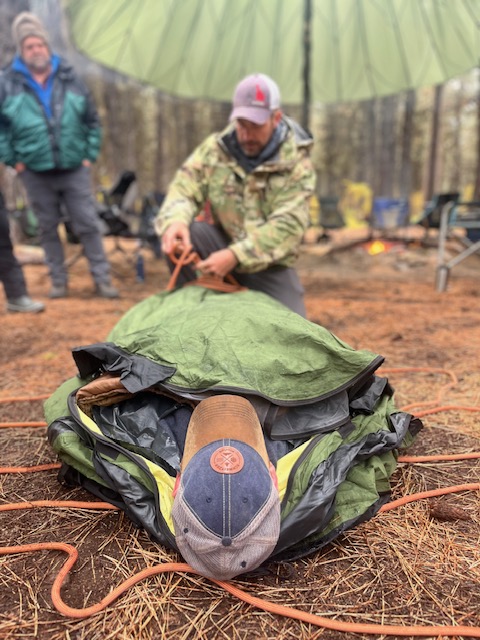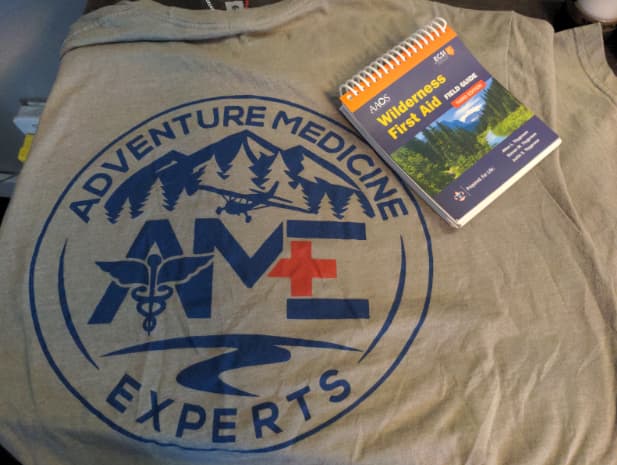At the end of September 2023, @theswayman and myself attended the first training course hosted by Adventure Medicine Experts- A company of 3 friends with extensive military experience in the fields of wilderness survival and trauma medicine. It was started on the premise of ‘military aircrews get survival training in austere environments, why not back-country general aviation pilots?’ Their inaugural course was 3-days and 2-nights next to the backcountry airstrip of Warm Springs, Idaho covering diagnostics and treatment of traumatic injuries, rescue signaling, shelter and fire building. Lots of class time, lots of hands-on experience.
The knowledge gained and notes taken between theswayman and myself after the fact filled many pages. I figured I’d write something of a review about it for those who may find such a course interesting.

I got almost everything I felt I had to have packed in my Eberlestock bag. In a yellow bin I packed my tent, sleeping bag, towel, drinks/snacks, and we figured it’d be good to have 5gal of fuel and water in the van for extra measure. Early Friday morning theswayman and myself left my place for the 3 hour drive to the airfield.
The group was our 3 instructors and 15 students, covering a broad range of age, geographic origin, flight and wilderness survival experience. We arrived to find our classroom already setup- a military parachute held up by a log and tied off to several trees, suspending it neatly over the firepit not far from the midfield point of the Warm Spring runway.

The facilities were nicer than expected: A pitcher-pump potable water well was on site, along with a US forest service bathroom. It was already more luxury than I had packed for, so that was nice. Personal camps ranged from one RV, to a couple large tents, and a couple 1-man tents like I was using. We pretty much just spread out among the trees next to the runway, except for 2 of the pilots that flew in pitching their tents right under the wings of their parked aircraft.
Also close by is Bonneville Hotsprings- a delightful location where water bubbles out of a hillside hot enough to boil your skin off! The steam rising up over where it meets the river was quite a sight. Hope you like the smell of sulfur…

We explored the hotsprings a bit while waiting for others to arrive and class to start. Once it began we had a classroom introduction, got our bearings with the schedule, and jumped right into the survival training.
The warmest part of the day was spent on the airfield with demonstrations and practice of signal fires, signal mirrors, improvised signals, land markers, and discussion on the use of strobes, chemlights, hand signals, and how to behave around rescue helicopters. Most of the ‘practical’ signaling would be some sort of ground-to-air visual signal, but methods of electronic communication were also discussed extensively. PLB’s (personal locator beacons), ELT’s (emergency locator transmitters, AKA PLB but onboard an aircraft with a G-sensor), and satellite communicators like Iridium phones and Garmin Inreach devices.

The fire craft portion was a huge confidence booster. I’ve used ferro rods for a while, and like them to the point I started manufacturing my own [shameless plug- https://www.etsy.com/listing/1703661950/metal-match-all-weather-ferro-rod-fire also ask some others on this forum how great they work ![]() ], but it turns out I still had a lot to learn about building a fire that would light off properly.
], but it turns out I still had a lot to learn about building a fire that would light off properly.
We used what our SERE instructor called a ‘brace’ method. Wherein the tinder bundle is built on some kind of platform like a large chunk of tree bark- to keep it contained and off of wet ground. Then a brace, a ~2’ stick, ideally with a bend in it, was placed on the far side of the tinder bundle, close to it. This provided a small, subtle wind-break to help light the tinder off, but once it started flaming it was a simple matter to pick it up just gently on one end to provide more air coming in underneath the tinder. This also provided spacing to dump a bunch of sticks on the tinder, but not smother it because one end of the sticks were on the brace.
Different tinder materials, different techniques for finding dry enough fuel would still alter the challenge, but overall with and without my favorite vaseline-soaked-cotton-ball tinder I had a pretty high success rate starting fires with nothing but a fixed blade and a ferro-rod.
Taking the ‘search’ out of search-and-rescue
Foolproof as these devices largely are, having an understanding of the technology behind it and the massive mechanism that is the North American search-and-rescue system is helpful in knowing what to expect, when to expect it, and how to prepare accordingly. Generally speaking in the continental United States, all 406Mhz emergency transmitters are picked up by the Airforce Rescue Coordination Center (US AFRCC) in Anchorage Alaska. That will usually get routed to a state facility (here in Idaho, the Idaho Transportation Department’s aeronautical division will get a call from AFRCC), wherein initial checks are made to determine if this is a legitimate emergency, or an accidental beacon activation (of which there are many). If it is determined that SAR must be launched, that usually starts with the sheriff’s office where the signal is coming from.
If they’re unable to affect a rescue (either in locating a crash or recovering victims from difficult terrain), the southern half of the state of Idaho is generally supported by units from the military side of Gowen Field (Boise airport) or Mountain Home Air Force base. The northern half of the state often gets support from Montana’s DOT as well as from a private company that fields technical rescue equipment from a small fleet of Augusta Westland helicopters.
All of which is to say that, given functioning satellite beacons, and sufficiently clear weather for aircraft operations, rescues for someone who has just hit the ‘oh shit! switch’ can be completed in extremely remote terrain in a matter of hours. When this gets difficult however is when night or weather conditions become such that aerial operations have to wait before moving into the mountains- which means that even with rescue aware of your location, having to spend a night or 2 in the woods can still have a high probability
Dress for egress
Much like biker’s have a saying ‘dress for the slide not the ride’, we had this good phrase for aviators drilled into us over the course. The best survival kit ever in the back of the plane, and the emergency satellite transponder built into the plane could both be equally useless if there’s a post crash fire. If there isn’t, great! If there is, what you’re wearing is likely the only survival gear you’ll have. I often fly with a small survival kit I built into an old milsurp compass pouch, but after this course if I’m going far into the backcountry I’m considering adding quite a bit more gear. A survival vest perhaps, or maybe some kind of small chest-rig/fanny pack of equipment that doesn’t interfere with manipulating the flight controls. A PLB would be my next addition. I should at least add a space blanket to my cargo pants pockets. Maybe I’ll stop leaving my headlamp in my flight bag on the back seat…
If it ain’t raining you ain’t training
After a beautiful 60F and sunny Friday afternoon, the clouds rolled in and it drizzled on and off starting that night and through the next 3 days. Those who flew in got in at the right time! After that conditions were largely IMC above ~1000ft, and it stayed like that long enough that those who flew in stayed an extra night and couldn’t leave until midday Monday. The humidity made it a bit chill at times but it stayed just above freezing at night, with highs in the 40’s for day 2 and 3.
We started our medical classroom training that evening, taking notes on the many acronyms designed to help us remember how to make a scene safe for rescuers (you can’t help someone else in dire straits if you make yourself a victim in the process), take assessments of patient conditions, and what to consider first if and when it becomes clear that an ambulance will not be arriving imminently.
Once classes concluded for the evening we finished setting up camp while dinner was prepped. Food was provided for the course, and besides being experienced pilots, wilderness adventurers, skydivers, rafters and trauma-docs our instructors also turned out to be skilled with the dutch oven. The meals were great all weekend and once the clouds set in, coffee was always on tap!

This is the River-Country trekking tent I spent 2 nights in. Not a generous amount of space but a bathtub floor and screened section large enough to sleep in and a covered space that kept the majority of my gear out of the weather. The wet conditions also made for good gear tests too- what needs more weatherproofing, what needs more practice setting up, what needs to be brought for a given temperature forecast.
For example my 0deg F Wiggy’s sleeping bag was much too warm for the 32+ temperatures. However thank goodness I had bought myself a pair of waterproof pants the week before this trip. That kept me dry enough to stay warm with not-quite enough layers given the high humidity. And believe me, rain or not everything started to get rather damp by night #2. Without fire it was clear things would have just stayed that way.
There was enough time left for theswayman and myself to make about a 2 mile trip uphill past the airfield. We climbed a bit over 1000ft on a narrow, rocky path before cresting the saddle between two summits. I regret not getting photos of more of the terrain, but aside from some initial airfield photos I do not regret chucking my phone in the van and forgetting about it for 3 days. No cell service where we camped!
We needed the headlamps for our return down the hill. The only other light around was the fire back at camp once we got out of the treeline. A small group of mule deer had crossed the trail and started bedding down on the hill above the runway, eying us suspiciously as we passed.
Day 2
The bulk of day #2 was more hands-on ‘modules’ of medical training categories. We rotated around with more signaling/survival kit considerations, practicing our fire-building skills, treating an injured person found with no obvious signs of the nature of the injury, major hemorrhage control, hypothermia treatment, and splinting/securing joints that may have been broken or sprained.

This is the part of the training I enjoyed the most. I had already taken a Stop The Bleed course at a local airport hanger a few months before, but doing it again was a good time reinforcing important details. SAM splints are something I had not worked with before, and there is some useful knowledge to have in how to position an injured limb beyond ‘keep it from moving’.
Saturday night we suffered a mere 80% casualty rate!
Our Friday and Saturday of class, practice and demonstrations led up to an evening simulated exercise of surviving a plane crash. The class was split into groups of 5 and moved far enough into the woods we couldn’t see or interact with the other groups. From that point we were given a basic pack of medical equipment, and told we all survived a crash in which no one was injured but everything else onboard went up in smoke. They didn’t even let us go back for gear from our campsite before leading us into the woods, so I’m glad I had at least been wearing my knife and ferro-rod when we started!
We found the best site we could to build a shelter within a limited walking distance. It wasn’t great for cover, but had decent resources and close enough trees to start putting up reflectors with a sleeping mat and a couple space blankets we had available. Two were shelter building, one was collecting firewood, one was collecting green-boughs for use in a signal fire, and I was working on getting said fire started. The platform-brade-multi-stick technique worked wonderfully as it had been, and we kinda had a signal/shelter/escape plan determined in a pretty orderly manner.
It was at this point we would start learning to get nervous when an instructor walks over…
One of us was asked to step away for a moment and talk with the instructor. Upon his return it was explained that our member had gone to the creek for water, slipped, hit his head and gotten soaked. Fortunately he was able to stumble his way back to camp, but only barely and he was not very coherent. So, we began hypothermia treatment- dry what we could, wrap in vapor barrier, assess head injury, check for further undetected injuries and place next to fire.
After that there was some discussion on what to do about the coming rain that night. We hadn’t much resources to create an actual cover, though the reflector setup was improving the warmth of the camp area nicely. A light drizzle we could handle, but a soaking rain we could not. The location we were at was a difficult one to find accessible foliage for a shelter cover- mostly grassy undergrowth of lodgepole-pine tree forests; the kind where branches don’t really start until 15’ up. A conclusion had not yet been made before another instructor came over to inform our primary shelter builder that he had just rolled his ankle, severely.
I was the only other un-injured in camp at the moment, and began treatment by splinting the ankle over his boot with a SAM splint, a tourniquet as a bottom ratchet-strap, and a cut duffle bag strap for the upper strap. Seemingly satisfied with my treatment, the instructor wandered off, presumably to inject some chaos into another group’s activities.
With the sprain secured he could hobble around a bit, fortunately we’d secured most of what we could for a campsite besides more firewood. Not long after I heard some distinct, strongly-worded yelling coming from the direction I last knew @theswayman to have been in search of dryer wood. Myself and the other mobile member of the group took off to see what was wrong, and about half way there our ER doc’s words about ‘remember scene safety’ came up in my head, and I realized it was silly to rush off to a possibly accident scene with no equipment. So I ran back to camp to grab what med supplies remained, and we met theswayman walking back to camp holding the forearm he’d slashed open trying to split branches with a knife.
One of the other groups was having a harder time getting their fire going, so while bandaging up the lacerations they ended up walking over to our fire. Well 4 of them anyway, #5 was their hypothermia patient, so the other 4 were transporting her via a makeshift litter made from a bivy sack and length of ¾” climbing rope. Being a simulated exercise at this point things had become, how can I say ‘delightfully hectic’. Apparently I’d been recognized as one of the firearms enthusiasts in the class (maybe my ‘I study triggernometry’ sweatshirt gave it away?); our SERE instructor therefore decided that I was the pilot who got us crashed, and my buddy got aggravated enough by this fact that he shot me in the leg…
So I had like 5 other people treat me for a GSW to the left thigh. Fun fact- tourniquets hurt going on, and they hurt coming off!
It had been about an hour and a half at this point, and since each group had pretty much been put through each of the major categories of injury and survival consideration we’d been trained for, started to wind things down. They seemed pleased with our efforts, and told us that since we seemed to have implemented the basics quickly and effectively, they took this as a good motive to turn up the heat, as it were. A good review was had and getting into late evening we cleaned up the area, thoroughly doused the practice fires, and returned to camp for dinner.
Standing on the west end of the runway as it got dark that evening was an ethereal view. The ground drops away steeply off that end, and the hills across the valley were completely obscured by the clouds and fog that continued to move closer. It gave the appearance of a road leading right off the edge of the earth
Day 3
Sunday morning was much more laid back, largely classroom discussion and reviewing lots of questions among the class. Some folks who drove in had to head out early, though by noon it was clear that all who flew in would be staying an extra night. That low ceiling just wouldn’t budge!
Our ideas of what equipment was most important to have along had changed considerably since we first discussed it Friday. A large trash bag or 3 might be #1 on my list now for all its usefulness in an imminent-risk-of-exposure emergency. I will definitely plan on wearing more of this equipment instead of just having it in the back of the plane. The Garmin Inreach Mini 2 will be on my shortlist of new gadgets to buy when I start backcountry training in earnest.
Discussions around the campfire before and after classes were always interesting. Pilots be pilots, and there are always stories to share about places we’ve been and things we’ve done. Plenty of adventure stories from the current/former military members in the group, and a number of engineers from fields I’ve always found fascinating to hear about.
Conclusion: Remember scene safety, always bring a trash bag, and don’t one-stick-it!
Upon completing the course, everyone received a Stop the Bleed and Emergency Care and Safety Institute wilderness 16-hour course certificate. Swag was also included, in the form of a cool t-shirt and waterproof wilderness medicine reference guide also published by ECSI.

To those who are pilots, friends of pilots, or otherwise think the idea of role-playing a plane-crash victim in the woods sounds like a great time, I completely recommend Adventure Medicine Experts of Nampa, Idaho for such training.